Silk Road › Silver in Antiquity » Ancient origins
Articles and Definitions › Contents
- Silk Road › Ancient History
- Silver in Antiquity › Antique Origins
Ancient civilizations › Historical and archaeological sites
Silk Road › Ancient History
Definition and Origins
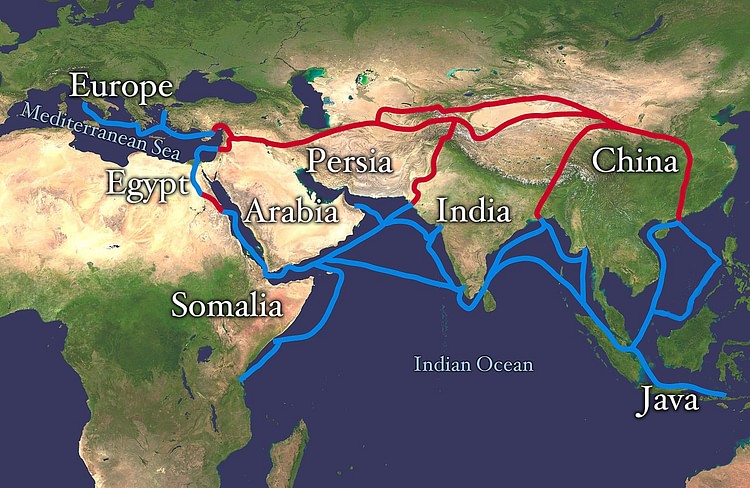
The Silk Road was an ancient network of trade routes, formally established during the Han Dynasty of China, which linked the regions of the ancient world in commerce between 130 BCE-1453 CE. As the Silk Road was not a single thoroughfare from east to west, the term 'Silk Routes' has become increasingly favored by historians, though 'Silk Road' is the more common and recognized name.
The European explorer Marco Polo (1254-1324 CE) traveled on these routes and described them in depth in his famous work but he is not credited with naming them. Both terms for this network of roads were coined by the German geographer and traveler, Ferdinand von Richthofen, in 1877 CE, who designated them 'Seidenstrasse' (silk road) or 'Seidenstrassen' (silk routes). Polo, and later von Richthofen, make mention of the goods which were transported back and forth on the Silk Road.
From West to East these goods included:
- Horses
- Saddles and Riding Tack
- The grapevine and grapes
- Dogs and other animals both exotic and domestic
- Animal furs and skins
- Honey
- Fruits
- Glassware
- Woolen blankets, rugs, carpets
- Textiles (such as curtains)
- Gold and Silver
- Camels
- Slaves
- Weapons and armor
From East to West the goods included:
- Silk
- Tea
- Dyes
- Precious Stones
- China (plates, bowls, cups, vases)
- Porcelain
- Spices (such as cinnamon and ginger)
- Bronze and gold artifacts
- Medicine
- Perfumes
- Ivory
- Rice
- Paper
- Gunpowder
The network was used regularly from 130 BCE, when the Han officially opened trade with the west, to 1453 CE, when the Ottoman Empire boycotted trade with the west and closed the routes. By this time, Europeans had become used to the goods from the east and, when the Silk Road closed, merchants needed to find new trade routes to meet the demand for these goods.
The closure of the Silk Road initiated the Age of Discovery (1453-1660 CE) which would be defined by European explorers taking to the sea and charting new water routes to replace over-land trade. The Age of Discovery would impact cultures around the world as European ships claimed some lands in the name of their god and country and influenced others by introducing western culture and religion and, at the same time, these other nations influenced European culture. The Silk Road - from its opening to its closure - had so great an impact on the development of world civilization that it is difficult to imagine the modern world without it.
PERSIAN ROYAL ROAD
The history of the Silk Road pre-dates the Han Dynasty in practice, however, as the Persian Royal Road, which would come to serve as one of the main arteries of the Silk Road, was established during the Achaemenid Empire (500-330 BCE). The Persian Royal Road ran from Susa, in north Persia (modern day Iran) to the Mediterranean Sea in Asia Minor (modern-day Turkey ) and featured postal stations along the route with fresh horses for envoys to quickly deliver messages throughout the empire. Herodotus, writing of the speed and efficiency of the Persian messengers, stated that:
There is nothing in the world that travels faster than these Persian couriers. Neither snow, nor rain, nor heat, nor darkness of night prevents these couriers from completing their designated stages with utmost speed. ( HistoriesVIII.98)
These lines would, centuries later, form the creed of the United States of America's post office. The Persians maintained the Royal Road carefully and, in time, expanded it through smaller side roads. These paths eventually crossed down into the Indian sub-continent, across Mesopotamia, and over into Egypt.
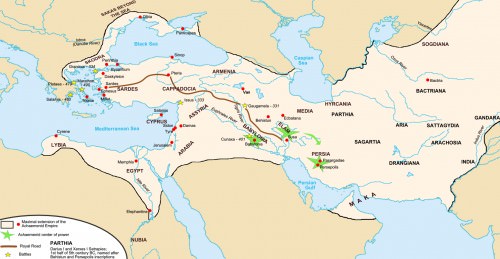
Persian Royal Road
CHINA & THE WEST
After Alexander the Great conquered the Persians, he established the city of Alexandria Eschate in 339 BCE in the Fergana Valley of Neb (modern Tajikistan). Leaving behind his wounded veterans in the city, Alexander moved on. In time, these Macedonian warriors intermarried with the indigenous populace creating the Greco-Bactrian culture which flourished under the Seleucid Empire following Alexander's death.
Under the Greco-Bactrian king Euthydemus I (260-195 BCE) the Greco-Bactrians had extended their holdings. According to the Greek historian Strabo (63-24 CE) the Greeks “extended their empire as far as the Seres” ( Geography XI.ii.i). `Seres' was the name by which the Greeks and Romans knew China, meaning `the land where silk came from'. It is thought, then, that the first contact between China and the west came around the year 200 BCE.
EMPEROR WU WAS EAGER TO GAIN NEW COMMODITIES THROUGH TRADE WITH THE WEST & THE SILK ROAD WAS OPENED IN 130 BCE.
The Han Dynasty of China (202 BCE – 220 CE) was regularly harassed by the nomadic tribes of the Xiongnu on their northern and western borders. In 138 BCE, Emperor Wu sent his emissary Zhang Qian to the west to negotiate with the Yuezhi people for help in defeating the Xiongnu.
Zhang Qian's expedition led him into contact with many different cultures and civilizations in central Asia and, among them, those whom he designated the `Dayuan', the `Great Ionians', who were the Greco-Bactrians descended from Alexander the Great's army. The Dayuan had mighty horses, Zhang Qian reported back to Wu, and these could be employed effectively against the marauding Xiongnu.
The consequences of Zhang Qian's journey was not only further contact between China and the west but an organized and efficient horse breeding program throughout the land in order to equip a cavalry. The horse had long been known in China and had been used in warfare for cavalry and chariots as early as the Shang Dynasty (1600 – 1046 BCE) but the Chinese admired the western horse for its size and speed. With the western horse of the Dayuan, the Han Dynasty defeated the Xiongnu. This success inspired Emperor Wu to speculate on what else might be gained through trade with the west and the Silk Road was opened in 130 BCE.
Between 171-138 BCE, Mithridates I of Parthia campaigned to expand and consolidate his kingdom in Mesopotamia. The Seleucid King Antiochus VII Sidetes (138-129 BCE) opposed this expansion and, also wishing revenge for the death of his brother, Demetrius, waged war against the Parthian forces of Phrates II, Mithridates successor. With the defeat of Antiochus, Mesopotamia came under Parthian rule and, with it, came control of the Silk Road. The Parthians then became the central intermediaries between China and the west.
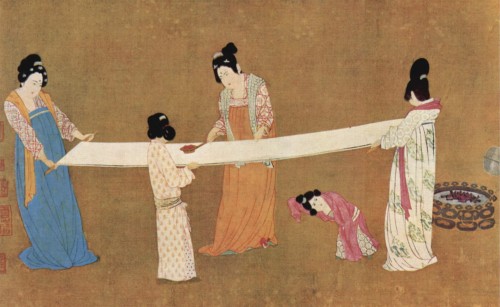
Women Checking Silk, Song China.
GOODS TRADED VIA THE SILK ROAD
While many different kinds of merchandise traveled along the Silk Road, the name comes from the popularity of Chinese silk with the west, especially with Rome. The Silk Road routes stretched from China through India, Asia Minor, up throughout Mesopotamia, to Egypt, the African continent, Greece, Rome, and Britain.
The northern Mesopotamian region (present-day Iran) became China's closest partner in trade, as part of the Parthian Empire, initiating important cultural exchanges. Paper, which had been invented by the Chinese during the Han Dynasty, and gunpowder, also a Chinese invention, had a much greater impact on culture than did silk. The rich spices of the east, also, contributed more than the fashion which grew up from the silk industry. Even so, by the time of the Roman EmperorAugustus (r.27 BCE – 14 CE) trade between China and the west was firmly established and silk was the most sought-after commodity in Egypt, Greece, and, especially, in Rome.
THE ROMAN LOVE OF SILK
Prior to becoming Emperor Augustus, Octavian Caesar seized on the controversial topic of silk clothing to denounce his adversaries Mark Antony (83-30 BCE) and Cleopatra VII (69-30 BCE) as immoral. As they both favored Chinese silk, which was increasingly becoming associated with licentiousness, Octavian exploited the link to deprecate his enemies. Octavian would triumph over Antony and Cleopatra ; he could do nothing, however, to curtail the popularity of silk.
The historian Will Durant writes:
The Romans thought [silk] a vegetable product combed from trees and valued it at its weight in gold. Much of this silk came to the island of Kos, where it was woven into dresses for the ladies of Rome and other cities ; in AD 91 the relatively poor state of Messenia had to forbid its women to wear transparent silk dresses at religious initiations. (329)
THE ISLAND OF KOS BECAME WEALTHY & LUXURIOUS THROUGH THEIR MANUFACTURE OF SILK CLOTHING.
By the time of Seneca the Younger (4 BCE – 65 CE), conservative Romans were more ardent than Augustus in decrying the Chinese silk as immoral dress for women and effeminate attire for men. These criticisms did nothing to stop the silk trade with Rome, however, and the island of Kos became wealthy and luxurious through their manufacture of silk clothing.
As Durant writes, " Italy enjoyed an 'unfavorable' balance of trade – cheerfully [buying] more than she sold” but still exported rich goods to China such as “carpets, jewels, amber, metals, dyes, drugs, and glass” (328-329). Up through the time of the emperor Marcus Aurelius (r.161-180 CE), silk was the most valued commodity in Rome and no amount of conservative criticism seemed to be able to slow the trade or stop the fashion.
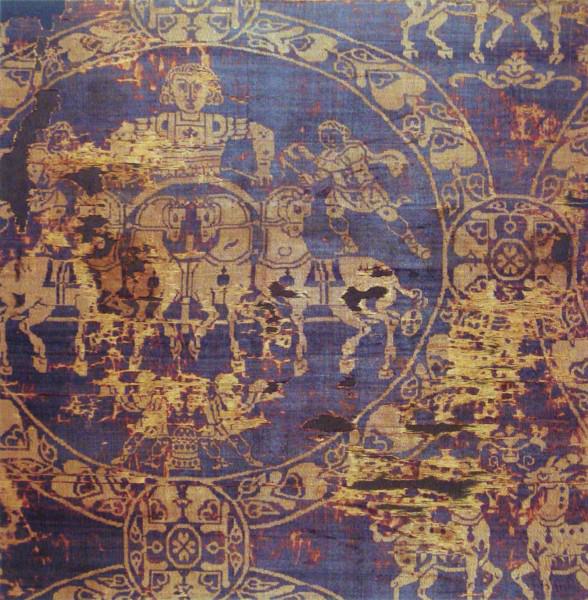
Tyrian Purple Shroud of Charlemagne
Even after Aurelius, silk remained popular, though increasingly expensive, until the fall of the Roman Empire in 476 CE. Rome was survived by its eastern half which came to be known as the Byzantine Empire and which carried on the Roman infatuation with silk. Around 60 CE the west had become aware that silk was not grown on the trees in China but was actually spun by silkworms. The Chinese had very purposefully kept the origin of silk a secret and, once it was out, carefully guarded their silkworms and their process of harvesting the silk.
The Byzantine emperor Justinian (527- 565 CE), tired of paying the exorbitant prices the Chinese demanded for silk, sent two emissaries, disguised as monks, to China to steal silkworms and smuggle them back to the west. The plan was successful and initiated the Byzantine silk industry. When the Byzantine Empire fell to the Turks in 1453 CE, the Ottoman Empire closed the Silk Road and cut all ties with the west.
THE SILK ROAD LEGACY
The greatest value of the Silk Road was the exchange of culture. Art, religion, philosophy, technology, language, science, architecture, and every other element of civilization was exchanged along these routes, carried with the commercial goods the merchants traded from country to country. Along this network disease traveled also, as evidenced in the spread of the bubonic plague of 542 CE which is thought to have arrived in Constantinople by way of the Silk Road and which decimated the Byzantine Empire.
The closing of the Silk Road forced merchants to take to the sea to ply their trade, thus initiating the Age of Discovery which led to world-wide interaction and the beginnings of a global community. In its time, the Silk Road served to broaden people's understanding of the world they lived in; its closure would propel Europeans across the ocean to explore, and eventually conquer, the so-called New World of the Americas. In this way, the Silk Road can be said to have established the groundwork for the development of the modern world.
Silver in Antiquity › Antique Origins
Definition and Origins
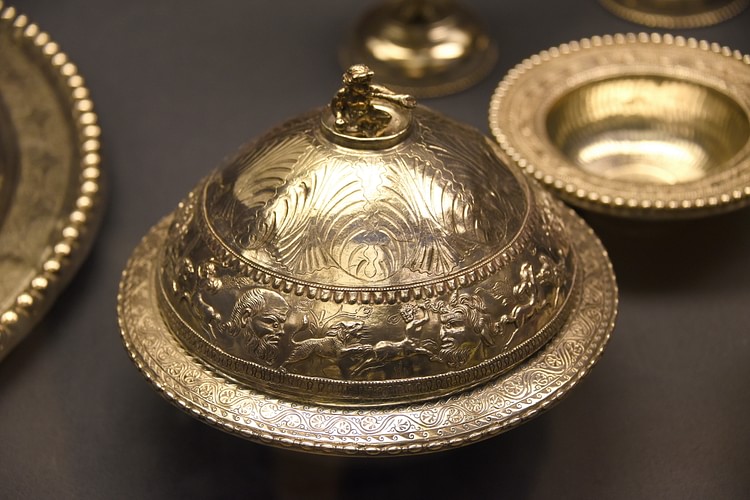
Silver had great value and aesthetic appeal in many ancient cultures where it was used to make jewellery, tableware, figurines, ritual objects and rough-cut pieces known as hacksilver which could be used in trade or to store wealth. The metal of choice to mint coinage for long periods, acquisition of silver mines in such places as Greece, Spain, Italy, and Anatolia was an important factor in many an ancient conflict. The metal was also found, amongst other places, in mines in ancient China, Korea, Japan, and South America where it was transformed into beautifully-crafted objects for elite use and to give as tribute and prestige gifts between states. Easily mined, worked, reusable, and brilliantly shiny, silver was one of the few truly international commodities which both connected and divided the ancient world.
PROPERTIES & MINING
Silver (Ag) is a soft metal which can be polished to produce an appealing lustre, two factors which made it ideal for ancient metalworkers to employ in their production of high-value goods. Silver was mined and smelted from ores such as lead carbonate (PbCO3) and galena (PbS). Ores usually contain less than 1% silver, but their abundance and lack of difficulty in smelting ensured ancient mining of the metal could be profitable, even from the Early Bronze Age. Smelting techniques improved over the centuries so that by the Classical period in Europe even low-grade ore could be exploited for the minute quantities of metal it contained. Indeed, smelting techniques made such progress that by Roman times it was possible to return to ore already treated (slag) in order to extract more silver from it. To strengthen the metal it was often alloyed with copper.
FOR THE INCAS SILVER WAS THOUGHT OF AS THE TEARS OF THE MOON.
Mining of silver in the Americas was largely done by digging vertical shafts into the ground. These tended to be shallow and so many were dug along an area of silver-bearing ore. Individual horizontal shafts were similarly short, only around one metre in length. Broken up using antler tools, the ore was crushed and smelted in clay crucibles. The Americas did not have bellows, and so the high temperatures needed for smelting were usually provided by several people blowing into the fire through tubes.As elsewhere, charcoal was used as the fuel source. Andean metalworkers were specialists at silver-plating and at producing alloys which mixed silver with gold, copper, and even platinum. Finished works were then often gilded or even painted.
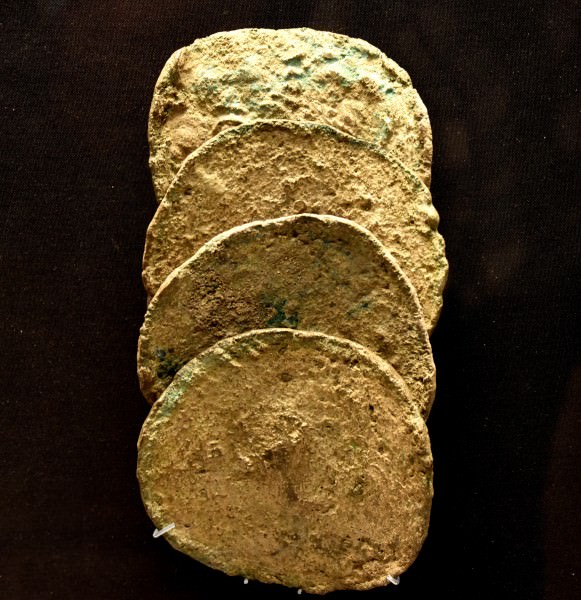
Silver Ingots from Syria
GEOGRAPHICAL AVAILABILITY
In Mesopotamia silver was used from the 4th millennium BCE. With no deposits in the area, silver was imported from Anatolia, Armenia, and Iran. Cities like Ugarit, Sumer, and Babylon used silver as a standard value measure with workers, for example, being paid in a specific weight of silver or its equivalent value in cereals. The Egyptians also valued silver and likewise acquired it through trade from Predynastic times, although silver archaeological finds are rarer than in other ancient cultures. This is perhaps because the Egyptians had their own sources of gold and only limited indigenous sources of silver.Certainly, silver was much closer in value to gold in ancient Egypt compared to other ancient cultures (1:2 instead of the more typical 1:13), and there were periods when it was considered even more valuable. In the Aegean, the Early Bronze Age cultures used silver which was mined from Attica (especially Laurion), the Cyclades, Thrace, and ancient Macedonia.
The Phoenicians, perhaps the greatest traders of them all, spread the use of silver even further across the ancient Mediterranean and channelled tons of it to western Asia, especially Assyria, mostly in the form of bullion (ingots, disks, and rings). The Phoenicians acquired such quantities that they earned an admonishing reference in the Bible : " Tyre heaped up silver" (Zechariah 9:2-3). To guarantee the weight and value, bars were stamped with official hallmarks. A Phoenician talent of silver weighed around 30 kilos and was worth 300 shekels. One silver shekel was worth 300 copper shekels and 227 shekels of tin. Gold was worth four times more than silver. Supply and demand affected the value of commodities just as they do today, and the oversupply of silver to the Near East caused a crash in the value of silver by the 6th century BCE.
Classical Athens benefitted from hitting a huge new seam on Mt. Pangaeus in Thrace, and both Carthage and Rome had a ready supply form Iberian mines and those on Sardinia. Indeed, the Romans worked some 40,000 slaves in the silver mines of Spain. The Etruscans did not go without, either, for they had access to silver in the north of their territory in Italy. By the later Roman period, as the empire expanded, silver was extracted from Britain, Germany, and the Balkans. Traded as coinage with peoples in India in exchange for spices and luxury goods, it was then converted back into bullion.
In the East, China's silver mines were exploited in the south from the 8th century CE, which led to the metal replacing silk as the primary method of bulk payment by merchants. In ancient Japan, silver was not extensively mined until the 16th century CE, but when it was, the metal became a handy method of payment with Portuguese traders who then spent it soon enough in their trade with China. So much silver went into the pockets of European traders - 20 tons a year - and the mines were worked out to such an extent that the Japanese government limited the silver taken out of the country from 1668 CE.
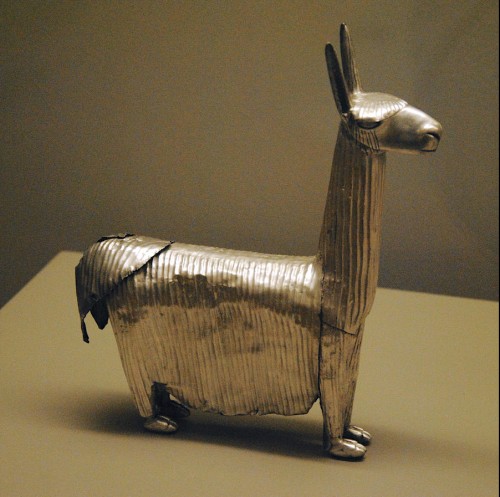
Inca Silver Alpaca
In the Americas, while the ancient Maya had plenty of gold, they had no silver of their own to speak of, but it was found in abundance further south, in the empires of the Incas and their predecessors. With plentiful supplies mined from northern South America (Colombia and Ecuador especially), the Moche, Wari, Lambayeque, and Chimu cultures all produced silverwork of the highest quality. For the Inca, just as gold was considered the sweat of the Sun, silver was thought of as the tears of the Moon. The rarity and prestige of the metal meant that it was restricted to use by the nobility; commoners had to make do with goods made from copper or bronze.
USES OF SILVER
Not as valuable as gold, silver was, nevertheless, used for much the same purposes but on a grander scale. Most ancient cultures benefitted from specialised craftsmen, often working for the royal household and given a dedicated area of the city to produce their shiny wonders. Jewellery, utensils, vessels, dishes, pepper castors, saucepans, figurines, masks, and decorative objects were made in silver. Silver, because of its high value, was widely used in objects related to religious rituals such as incense burners, relics containers, and votive offerings or dedications. Textiles were embroidered with silver thread, and items of clothing had pieces of silver sewn onto them. The metal was also widely used as an inlay material in such items as weapons, armour, furniture, and metal vessels.
HACKSILVER
Long before coins came along, silver in the form of ingots and rough cut pieces was a common method of payment for traders and states alike. This latter form, known as hacksilver (or hacksilber), was also used as a method to store wealth and was frequently buried, leading to spectacular archaeological finds of long-hidden hoards. Being roughly cut off from old jewellery, ingots, and basically anything made from pure silver, it was weighed each time a transaction was made, which often resulted in pieces being cut again and again to meet the exact weight required and, as a result, the pieces became ever smaller. The practice was common in the Near East, Egypt, and the ancient western Mediterranean up to the 4th century BCE when coinage largely replaced it. Hacksilver and silver ingots of no particular standardised weight were used in ancient India from the 8th to 7th century BCE. Small bent bars are typical, and judging by their differing weights, smaller pieces were probably cut from them before coinage became common.

The Taranto Hoard
Many hacksilver hoards include silver coins and so illustrate the gradual transition from one form of wealth storage to another.Spain, in particular, was an area where the habit of using hacksilver lingered on well into the 1st century BCE. With the demise of the Roman empire coinage production fell dramatically and hacksilver was, once again, the primary means to keep wealth and pay for goods. The Vikings, especially, were great savers of chopped up silver bits if the quantity of hoards discovered across central Europe, Britain, and Scandinavia are anything to go by.
SILVER COINAGE
One of the most common uses of silver throughout antiquity was as coinage. During the 6th century BCE, the first coins were minted in Lydia, which were made of electrum, a natural alloy of gold and silver, or of pure gold or pure silver. They were stamped with a design by the state as a mark of their authenticity and weight.
The first Greek coins appeared at Aegina c. 600 BCE (or even earlier), which were silver and used a turtle design as a symbol of the city's prosperity based on maritime trade. Athens and Corinth soon followed Aegina's lead. Heated discs of silver were hammered between two dies engraved with the designs. The birth of coinage in wider Greece, though, was not really an invention of convenience but a necessity, driven by the need to pay mercenary soldiers. These warriors required a convenient way to carry their wages, and the state needed a method of payment they could equally apply to everyone.
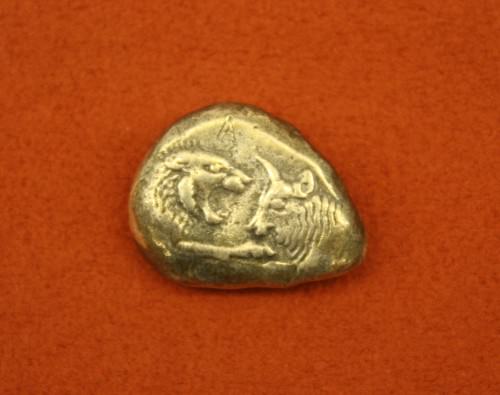
Lydian Silver Stater
Around 510 BCE Darius I introduced coinage in Persia, which included the silver shekel which weighed around 5.5 grammes.The master traders the Phoenicians long preferred the universal acceptability of silver bullion wherever their trade tentacles reached but, eventually, they too succumbed to progress. The first Phoenician coins were minted at Kition c. 500 BCE, then at Byblos c. 470 BCE. Other cities soon followed suit, Sidon and Tyre introducing silver coins around 450 BCE.
Coinage solved one problem but posed another, raising the interesting question of metal purity. The ancients were not aware of the concept of elements and their inherent properties, but smelters, through the necessity of creating coinage that was of a standardised weight, did manage to reach a purity of silver of around 98%. Silver coins were of relatively high value, perhaps equal to one week's work for most citizens. Only in the Hellenistic Period did smaller denominations become more widespread.
The first Roman silver coins were produced from the early 3rd century BCE and resembled contemporary Greek coins. C. 211 BCE a whole new coinage system was introduced. Appearing for the first time was the silver denarius (pl. denarii), a coin that would be the principal silver coin of Rome until the 3rd century CE. Following the acquisition of the silver mines in Macedonia from 167 BCE, there was a huge boom in silver coins from 157 BCE. Gradually, as emperors spent more frivolously and wars drained the state coffers, silver coins went from almost pure to 70% then 50% and on down until they reached an all-time low of just 2% silver content.
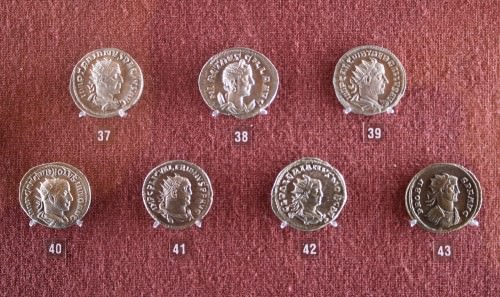
Roman Empire Silver Coins
Chinese coins, with their distinctive square central hole, were first produced in the second half of the first millennia BCE, but they were always made of copper. Coinage arrived in ancient India around the 6th century BCE. The ancient Americas had no coinage, but silver, like other precious materials such as gold and textiles, was used for trading purposes. Silver was highly valued and goods made from it were used as gifts and tribute, but their specific value depended on each item and the context in which it was given.
One final form of currency, in use in Korea from the 12th to 14th century CE, was the unbyong silver vase, stamped by the state and given an official rate of exchange with staple commodities such as rice; it was shaped like the peninsula of Korea.Unfortunately, no examples survive, but we do know from a 1282 CE law that the value of one unbyong was fixed at between 2,700 and 3,400 litres of rice. Despite their impracticality for smaller transactions, the vases continued to be used over the next two centuries, until King Chungyol permitted rough or broken pieces of silver to be used instead at the end of the 13th century CE.
LICENSE:
Article based on information obtained from these sources:with permission from the Website Ancient History Encyclopedia
Content is available under License Creative Commons: Attribution-NonCommercial-ShareAlike 3.0 Unported. CC-BY-NC-SA License